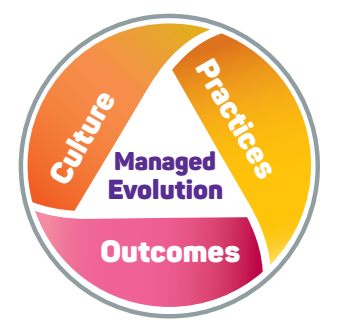David J. Anderson and Teodora Bozheva actively teach the model to KMPs and coaches working to develop further the business agility of their clients. All this experience and feedback allowed to understand better what challenges organizations face and how Kanban helps to overcome them.
Since the publishing the beta release of the Kanban Maturity Model a year and a half ago, a number of Kanban Coaching Professionals have used it in different organizations and business fields. Susanne Bartel, Steve McGee, Minton Brooks, Brad Hughes, Frank Vega, Ivaylo Gueorguiev, Kaveh Kalantar, Amit Kaulagekar, Pavel Klimenko, Ivan Font and I 😊 are some of them.
David J. Anderson and I are actively teaching the model to Kanban Management Professionals and coaches working to develop further the business agility of their clients.
All this experience and feedback has allowed us to understand better what challenges organizations face on the path towards their purpose and how Kanban practices and values help them overcome the drawbacks. Release 1.1 of the visual materials and the upcoming book include the additional knowledge we have gained and codified so that organizational change agents can take advantage of it.
More precisely, these are the updates which you will find:

- Better descriptions of the maturity levels (ML) showing how organizations evolve developing their fitness-for-purpose. More precisely, how they improve in the following aspects:
- new habits and cultural values
- deeper Kanban management practices
- relief from overburdening
- coherent decision making al all levels, taking into account tactical, operational and strategic concerns
- consistent and efficient work process
- alignment and unity around a shared purpose
- better business outcomes
- capabilities to anticipate and address changes in the business environment
- Updated list of cultural values: currently KMM defines 34 values vs 20 in the beta release. All these facilitate the adoption of the Kanban thinking at all levels of an organization and the successful leadership of cultural change initiatives.
- Introducing the Flow Manager role at ML2 – focused mainly on understanding demand and capacity and reducing delays by means of analysing the blocker and rework causes and implementing appropriate improvement actions. This role evolves to Service Delivery Manager at ML3.
- Introducing the Service Delivery Manager role at ML3 managing the flow of committed work downstream ensuring sustainable delivery of fit-for-purpose services.
- Introducing the Service Request Manager role at ML3 managing the flow of options upstream.
- Additional Specific Practices and improved practice description. Release 1.1 contains 150+ practices compared to 132 in the beta release. They all include description of the intent of the practice and more detailed guidance on how to implement it.
How can you use the updated visual materials?
- The A3 poster summarizes what benefits organizations get from KMM and how culture and practices scale across the maturity levels. Use it to explain what the model brings to an organization in terms of culture, practices and business outcomes, facilitate the definition of appropriates objectives, and involve the right management people.
- The A0 poster lists the titles of the practices and values per ML. Use them to identify appropriate practices that can address the needs of your organization.
- Use both posters to find out where your organization is and develop a roadmap for evolving it further avoiding known barriers or overreaching.
How to get started with KMM?
- Download release 1.1 of the materials from the KMM web site
- Visit the David J Anderson School of Management and register for the KMM and Kanban Coaching Practices courses to take advantage of this codified knowledge and experience
- Read the upcoming book
- Contact us, if you have questions


